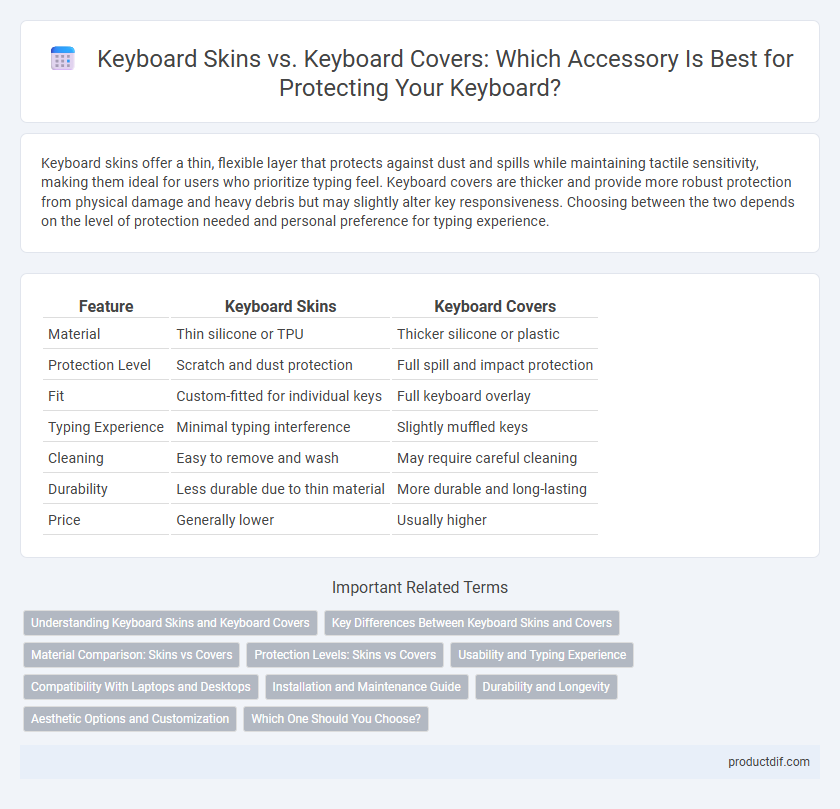Keyboard skins offer a thin, flexible layer that protects against dust and spills while maintaining tactile sensitivity, making them ideal for users who prioritize typing feel. Keyboard covers are thicker and provide more robust protection from physical damage and heavy debris but may slightly alter key responsiveness. Choosing between the two depends on the level of protection needed and personal preference for typing experience.
Table of Comparison
| Feature | Keyboard Skins | Keyboard Covers |
|---|---|---|
| Material | Thin silicone or TPU | Thicker silicone or plastic |
| Protection Level | Scratch and dust protection | Full spill and impact protection |
| Fit | Custom-fitted for individual keys | Full keyboard overlay |
| Typing Experience | Minimal typing interference | Slightly muffled keys |
| Cleaning | Easy to remove and wash | May require careful cleaning |
| Durability | Less durable due to thin material | More durable and long-lasting |
| Price | Generally lower | Usually higher |
Understanding Keyboard Skins and Keyboard Covers
Keyboard skins are thin, flexible silicone overlays designed to protect individual keys from dust, spills, and wear while preserving the tactile feel and visual layout of the keyboard. Keyboard covers, often made from thicker materials, provide full surface protection, safeguarding the keyboard not only from dirt and spills but also from physical damage and debris accumulation. Understanding the differences in material thickness, protection level, and tactile experience is essential for choosing the right accessory to enhance keyboard durability and user comfort.
Key Differences Between Keyboard Skins and Covers
Keyboard skins are thin, flexible layers made of silicone that fit directly over the keys, providing spill protection and a smooth, quiet typing experience while maintaining key visibility. Keyboard covers, often made from thicker plastic or rubber, serve as rigid protective shields that guard against dust, debris, and physical damage but may alter key feel and reduce typing accuracy. The primary differences lie in material thickness, tactile feedback, and the level of protection they offer against environmental hazards.
Material Comparison: Skins vs Covers
Keyboard skins, typically made from thin, flexible silicone, provide a snug, tactile layer that preserves key sensitivity while protecting against minor spills and dust. In contrast, keyboard covers use thicker, more rigid materials such as polyurethane or thermoplastic, offering enhanced durability and robust protection from heavy spills and debris. The choice between skins and covers hinges on balancing a lightweight, responsive feel against sturdier, more comprehensive keyboard safeguarding.
Protection Levels: Skins vs Covers
Keyboard skins offer a thin, flexible layer that protects against dust, minor spills, and everyday wear while maintaining tactile feedback. In contrast, keyboard covers provide more robust protection against liquid spills, crumbs, and dirt by fully encasing the keys, often resulting in a slightly altered typing experience. Choosing between skins and covers depends on the desired balance between protection level and typing comfort.
Usability and Typing Experience
Keyboard skins offer a thin, flexible layer that protects against dust and spills without significantly altering the typing feel, maintaining tactile sensitivity and key response. Keyboard covers tend to be thicker, providing enhanced protection from dirt and impact but often reducing key travel and potentially leading to a less comfortable typing experience. Choosing between the two depends on balancing the need for protection with the preference for a natural typing sensation.
Compatibility With Laptops and Desktops
Keyboard skins provide a thin, flexible layer that conforms precisely to the keys of specific laptop models, ensuring optimal compatibility and maintaining tactile responsiveness. Keyboard covers, typically thicker and made from silicone or plastic, offer broader compatibility with various laptop and desktop keyboards but may slightly alter key sensitivity. Selecting between skins and covers depends on the device's keyboard layout and user preference for protection versus typing experience.
Installation and Maintenance Guide
Keyboard skins offer a thin, flexible layer that easily slips over keys, requiring minimal installation effort, whereas keyboard covers typically involve a more structured design that snaps or fits snugly over the keyboard frame. To maintain keyboard skins, regular cleaning with a damp cloth and mild soap ensures longevity without damaging the material, while keyboard covers may require frequent removal and washing to prevent dust accumulation under the cover. Proper installation and routine maintenance of both accessories protect against spills, dust, and wear, enhancing keyboard durability and typing comfort.
Durability and Longevity
Keyboard covers typically offer greater durability by providing a thicker barrier against spills, dust, and wear compared to thinner keyboard skins designed primarily for aesthetics. High-quality silicone or TPU keyboard covers can withstand repeated use and cleaning without degrading, ensuring prolonged protection and device longevity. In contrast, keyboard skins often wear out faster due to their slim material but can be easily replaced to maintain keyboard appearance.
Aesthetic Options and Customization
Keyboard skins offer a wide range of aesthetic options with vibrant colors, intricate patterns, and customizable designs that allow users to personalize their device easily. In contrast, keyboard covers typically focus on functional protection with limited design choices, often available in transparent or solid colors. For users seeking extensive customization and stylistic expression, keyboard skins provide a more versatile and visually appealing accessory.
Which One Should You Choose?
Keyboard skins offer a thin, flexible layer that protects against dust and minor spills without altering the typing experience, making them ideal for users seeking subtle protection. Keyboard covers provide a more robust shield, safeguarding against liquid damage and debris while often including a textured surface for enhanced grip and comfort. Choosing between keyboard skins and covers depends on the level of protection desired and the user's preference for typing feel and device aesthetics.
Keyboard skins vs keyboard covers Infographic

 productdif.com
productdif.com